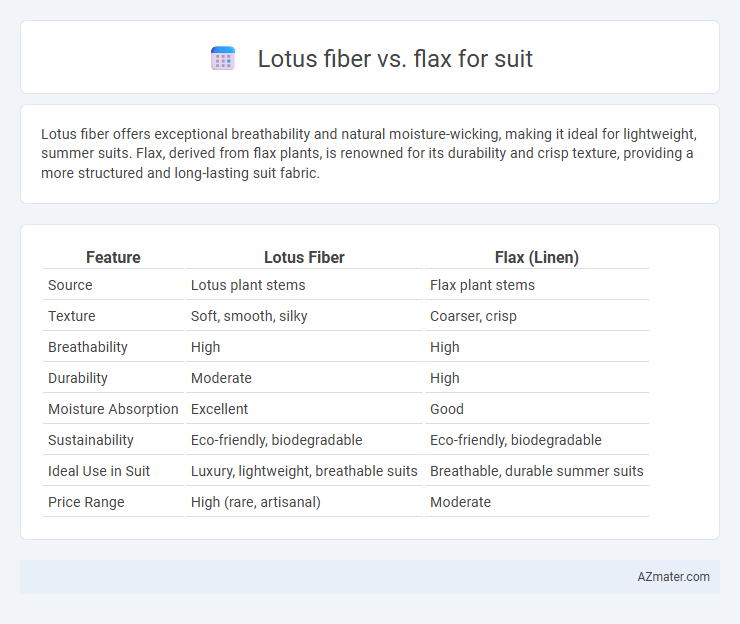Lotus fiber offers exceptional breathability and natural moisture-wicking, making it ideal for lightweight, summer suits. Flax, derived from flax plants, is renowned for its durability and crisp texture, providing a more structured and long-lasting suit fabric.
Table of Comparison
| Feature | Lotus Fiber | Flax (Linen) |
|---|---|---|
| Source | Lotus plant stems | Flax plant stems |
| Texture | Soft, smooth, silky | Coarser, crisp |
| Breathability | High | High |
| Durability | Moderate | High |
| Moisture Absorption | Excellent | Good |
| Sustainability | Eco-friendly, biodegradable | Eco-friendly, biodegradable |
| Ideal Use in Suit | Luxury, lightweight, breathable suits | Breathable, durable summer suits |
| Price Range | High (rare, artisanal) | Moderate |
Introduction: The Rise of Natural Fibers in Suits
Lotus fiber and flax are gaining traction in the suit industry due to their sustainable and eco-friendly properties. Lotus fiber, derived from the lotus plant, offers natural breathability and strength, making it an innovative choice for luxury suits. Flax, the source of linen, is valued for its lightweight texture and moisture-wicking capabilities, providing comfort and durability in tailored garments.
Lotus Fiber and Flax: Origin and Sustainability
Lotus fiber, derived from the stems of lotus plants mainly in Southeast Asia, is a rare and eco-friendly textile known for its natural biodegradability and minimal resource use, making it highly sustainable for suit fabrics. Flax, originating from the Linum usitatissimum plant cultivated primarily in Europe and North America, produces linen, a durable and breathable material favored for its renewable cultivation and low environmental impact. Both fibers offer sustainable alternatives to conventional fabrics, with lotus fiber standing out for its unique harvesting process requiring no pesticides or intensive water use.
Fiber Extraction Process: Lotus vs Flax
Lotus fiber extraction involves harvesting the lotus stem, followed by a labor-intensive process of retting and gently scraping fibers to preserve their delicate structure, resulting in fine, breathable yarn ideal for luxury suits. Flax fiber extraction requires retting the flax stalks to separate fibers, then scutching and hackling to refine the fibers into soft, strong linen suitable for tailored suits with durability and natural luster. The lotus process emphasizes handcrafting and sustainability, while flax benefits from more mechanized methods and widespread availability, influencing the texture and exclusivity of each suit fabric.
Texture, Feel, and Comfort Comparison
Lotus fiber offers a unique texture that is smooth yet slightly coarse, providing a natural, breathable feel ideal for luxury suits. Flax, used in linen, is known for its crisp texture and excellent moisture-wicking properties, enhancing comfort in warm climates. While lotus fiber excels in softness and durability, flax is prized for its lightweight, cooling sensation, making each fiber distinct in suit applications.
Breathability and Moisture-Wicking Qualities
Lotus fiber offers exceptional breathability due to its naturally hollow structure, allowing air circulation that keeps the wearer cool and comfortable. Flax, derived from the flax plant, is known for its strong moisture-wicking abilities that absorb sweat and release it quickly, enhancing dryness in warm conditions. Both fibers provide superior ventilation and moisture management, but lotus fiber's unique cellular design gives it an edge in maintaining optimal airflow for suits.
Durability and Longevity of Suit Fabrics
Lotus fiber suits offer exceptional durability due to the fiber's natural strength and resistance to wear, making them ideal for long-lasting garments. Flax, the raw material for linen, is renowned for its robustness and ability to maintain structural integrity over time, ensuring suits retain their shape and texture. Both fibers provide durable options, but lotus fiber's unique cell structure grants superior longevity in frequent-use suits compared to traditional flax-based fabrics.
Aesthetic Appeal: Visual Differences in Suits
Lotus fiber suits exhibit a unique matte finish with a subtle sheen, offering a soft, natural texture that enhances the garment's visual depth. Flax, the material for linen suits, displays a coarser weave and a distinctive natural luster, creating a crisp and breathable aesthetic ideal for warm weather attire. The visual difference lies in Lotus fiber's smooth elegance compared to Flax's textured, casual appearance, influencing suit style and formality.
Eco-Friendliness and Environmental Impact
Lotus fiber and flax both offer eco-friendly alternatives to conventional suit fabrics, with lotus fiber being biodegradable, requiring minimal water, and benefiting from natural pest resistance, which reduces chemical use. Flax, used to produce linen, demands moderate water and pesticide inputs but is highly renewable, rapidly biodegrades, and enhances soil health through crop rotation. Comparing environmental impact, lotus fiber excels in water conservation and chemical reduction, while flax contributes significantly to sustainable agriculture and lower carbon emissions.
Cost and Availability in the Market
Lotus fiber suits typically incur higher costs due to the labor-intensive extraction process and limited large-scale production, resulting in lower market availability compared to flax suits. Flax, commonly processed into linen, benefits from extensive cultivation and established supply chains, making it more affordable and widely available. Suit manufacturers often favor flax fiber for its cost-efficiency and consistent availability in global textile markets.
Which Fiber is Better for Suits: Lotus or Flax?
Lotus fiber offers exceptional breathability, natural antibacterial properties, and a unique textured appearance, making it ideal for lightweight, comfortable suits in warm climates. Flax, derived from flax plants and commonly processed into linen, provides durability, moisture-wicking capabilities, and a classic crisp look favored for formal suits. For suits, flax is generally better suited due to its proven strength, wrinkle resistance, and versatile finishing options, whereas lotus fiber suits excel in niche markets emphasizing sustainability and luxury.

Infographic: Lotus fiber vs Flax for Suit
 azmater.com
azmater.com